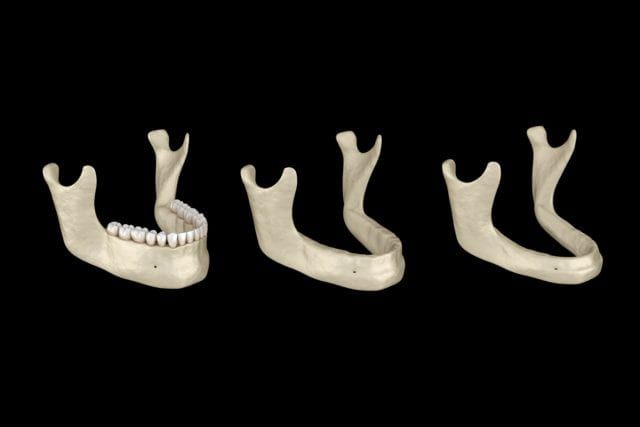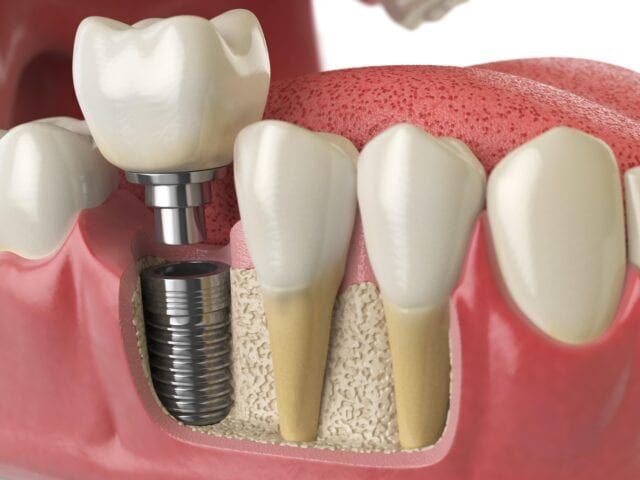Dental implants have become a popular option for patients with missing teeth, but they are not always suitable for everyone. One of the biggest limitations is significant bone loss in the jaw, which can make traditional implant procedures challenging or impossible. However, mini dental implants (MDIs) offer an alternative solution for patients with significant bone loss, allowing them to enjoy the benefits of dental implants without the need for extensive bone grafting or other complex procedures. Whether you’ve lost a tooth due to an accident or decay, mini dental implants may be able to help. Unlike traditional implants, which require a large amount of healthy bone for support, mini dental implants can be used in patients with significant bone loss. Keep reading to learn more about this treatment option and see if it’s right for you.
What are Mini Dental Implants (MDIs)?
Mini Dental Implants (MDIs) are a revolutionary dental technology that offer an effective and affordable way to replace missing teeth. Like traditional implants, the mini dental implant resembles a screw and is designed to fit snugly into the jawbone where the missing tooth used to be. Mini dental implants are smaller in diameter than traditional implants, typically less than 3mm in diameter. They are made of titanium, just like regular implants, but their smaller size makes them easier to place and more versatile. MDIs can be used to replace a single missing tooth, multiple missing teeth, or to stabilize dentures.
How MDIs Differ from Traditional Implants
Many people wonder how mini dental implants compare with traditional dental implants. The table below shows a basic comparison of the two:
| Mini Dental Implants (MDIs) | Traditional Dental Implants | |
| Size | Smaller diameter, typically less than 3mm | Larger diameter, typically 3.5mm or more |
| Placement | Placed in a less invasive way and usually in a single visit | More invasive placement and may require multiple visits |
| Healing time | Usually faster healing time due to less invasive placement | Longer healing time, usually 3-6 months |
| Bone density | Require less bone density, making them a good option for patients with significant bone loss | Require sufficient bone density for successful placement |
| Stability and support | May not provide the same level of support as traditional implants, but can still provide stability for dentures or bridges | Offer a higher level of stability and support, especially for full arch replacement |
| Cost | Generally more affordable than traditional implants | Generally more expensive than MDIs |
| Candidates | Suitable for patients with significant bone loss or those who want a less invasive option | May not be suitable for patients with significant bone loss or those who need a higher level of support |
It’s worth noting that the specifics of the implant procedure, materials, and other factors can vary between individual cases, and it’s important to consult with a dental professional to determine the best implant option for your particular needs.
Advantages of MDIs
Mini dental implants offer a great advantage over traditional full-length dental implants for patients with significant bone loss. Some of these advantages include:
- MDIs smaller and less invasive
- Do not require additional procedures such as bone grafts or sinus lifts
- Can often be placed in just one visit
- Have a faster healing time
- Ideal for securing dentures or bridges
For all these reasons, mini dental implants are quickly becoming the preferred option for patients with severely deteriorated jawbones looking for a secure solution for their dental needs.
How Do I Know If I Have Significant Bone Loss?
Significant bone loss can be a challenging issue for patients seeking dental implant treatment. Significant bone loss in the jaw can be caused by a variety of factors, such as periodontal disease, trauma, tooth loss, or aging. When the jawbone is too thin or weak to support traditional implants, patients may be turned away as a candidate for implant surgery.

Patients with significant bone loss in the jawbones can have a difficult time achieving successful implant candidacy. This is because the implant needs to be able to bond with the surrounding healthy bone in order for it to remain secure and stable. If there is insufficient healthy bone, then the implant may not properly integrate into the jawbone, resulting in compromised stability. In some cases, this can even lead to dental implant failure. To prevent implant failure and additional procedures, many dentists won’t place implants in patients with low bone mass.
If you are considering dental implants, you may be wondering if you have enough healthy bone to support the implants. The best way to determine this is to visit an implant dentist for a thorough dental exam and CT scan. While general dentists can place dental implants, a dental implant dentist is better equipped to handle more challenging cases, such as low bone mass. During this appointment, your implant dentist will examine the condition of your jawbone and take X-rays or a CT scan to measure its density and thickness. They will also assess the amount of healthy bone needed to support a traditional dental implant and compare that with the amount available. When there is not an adequate amount of jawbone density to support traditional implants, mini dental implants may be recommended.
- Significant bone loss in the jaw can be caused by a variety of factors
- Patients with significant bone loss in the jawbones can have a difficult time achieving successful implant candidacy
- Best way to determine bone mass is to visit an implant dentist for a thorough dental exam and CT scan
- An implant dentist is more experienced with placing implants in patients with low bone mass
MDIs for Patients with Significant Bone Loss
Mini Dental Implants (MDIs) are a great solution for many patients with significant bone loss due to jaw disease, age-related issues, medications, or trauma. MDIs are much smaller than traditional dental implants and may be able to adapt to lower bone volumes more effectively. This means they can create more stability and have greater retention rates in people with low bone mass than conventional dental implants. As MDIs require less abutment space, they may be the best option for patients who have nowhere else on the jawline that has enough healthy bone mass to secure an implant. Furthermore, in cases where there is limited bone height left in the oral cavity, these smaller implants may provide the opportunity for longer-term corrective results that would otherwise not be achievable by other solutions.
- MDIs ideal for low bone mass
- Provide opportunity for implants that would otherwise not be achievable
Procedure for MDIs for Patients with Significant Bone Loss
Mini Dental Implants, also known as MDIs, offer a great way for patients with significant bone loss to retain a functional, secure smile. The MDI procedure includes a few key steps. To begin, an initial consultation is performed where tests are done to assess any remaining bone levels and gums in order to ensure that the MDI implant is suitable for each individual patient. Once cleared for the procedure, a surgical protocol is outlined which includes preoperative and postoperative instructions, the use of sedation or local anesthesia if needed, and what to expect during the procedure.

The procedure to place mini dental implants is pretty straightforward. This procedure involves making a small hole in the jawbone that precisely fits the implant. The MDI is then inserted and tightened into place, and a small cap is placed on top to protect the implant. If multiple implants are being placed, then this process will be repeated to place each implant. In most cases, the entire process can be completed in a single office visit and the patient will be able to eat and speak normally the same day as the procedure. Afterward, patients should attend scheduled medical follow-ups post-procedure to allow dentists to assess healing as well as discuss any resulting issues that may need further attention or treatment.
Although the procedure to place MDIs is pretty similar to the procedure used to place traditional implants, there are a few key differences. For starters, MDIs eliminate the need for supplemental procedures such as bone grafts and/or sinus lifts, which are often necessary for traditional implant placement in people with low bone mass. Additionally, traditional dental implant placement usually requires two procedures: one to place the implant screw and another to place the dental prosthetic once the implant has healed. Mini dental implants, on the other hand, only require one procedure. These key differences make mini dental implants more cost-effective and significantly reduce recovery time when compared to traditional implant procedures.
- MDI procedure is slightly different than a traditional implant procedure
- Can be completed in a single office visit
Post-Procedure Care
Post-procedure care for patients with mini dental implants is incredibly important for the success of the implant. Immediately after the procedure, patients should rest and avoid eating hard or tough foods as well as drinking straws or hot beverages. To ensure a successful implantation, it is also essential that patients practice good oral hygiene and routinely floss and brush their teeth twice a day to remove any remaining bacteria. Additionally, they should visit their dentist regularly for routine check-ups and post-operative appointments to ensure that there are no signs of infection. With careful maintenance, these dental implants can provide a long-term tooth replacement solution for those who have experienced significant bone loss due to injury, disease, or birth defects.
- Post-procedure care essential for implant success
- Avoid eating hard foods
- Maintain good oral hygiene
Limitations and Risks of MDIs
While MDIs offer many advantages, they are not suitable for all patients. Therefore it is important to recognize any limitations related to MDI prior to starting treatment. Some potential limitations include their smaller size, which may not provide the same level of support as traditional implants, and the risk of implant failure due to the decreased bone density in the jaw. Additionally, like any dental procedure, there are risks and complications associated with MDIs, such as infection, nerve damage, or implant failure. Although the success rate of MDI implants is very high, implant success depends on several factors, including the condition and density of the jawbone — as well as the patient’s age and oral hygiene habits. It is important to discuss the risks and benefits with your dentist before making a decision. It is also essential to work with a dental implant professional who has experience in performing mini dental implant treatments to make sure that the most appropriate treatment is chosen for you.
- Not suitable for all patients
- Have risks like any dental procedure
- Success depends on several factors
In Conclusion
Overall, MDIs are an option for patients with significant bone loss who want dental implants, as they offer a more accessible and affordable solution to traditional implant procedures. While there are some limitations and risks associated with MDIs, they can provide a stable and secure solution for replacing missing teeth or supporting dentures in people with low bone mass. If you are considering MDIs, talk to your local implant dentist to determine if they are a suitable option for you. With proper care and maintenance, MDIs can provide a long-lasting and functional solution for your smile.

